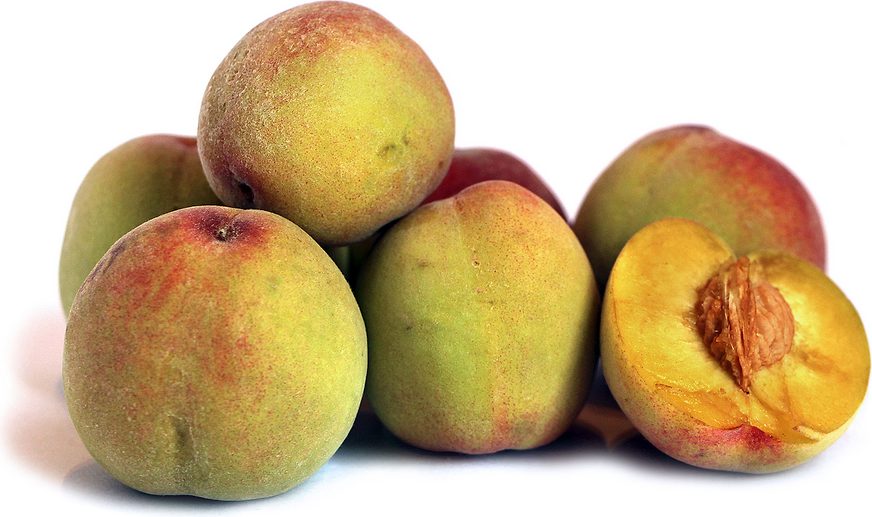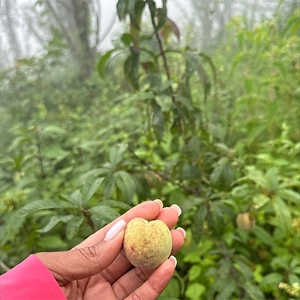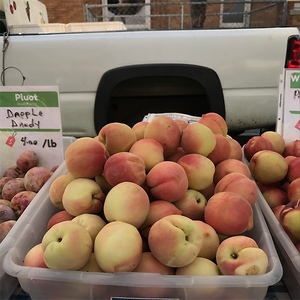


Wild Peaches
Estimated Inventory, ea : 0
Description/Taste
Wild peaches are small fruits with a rounded base, measuring approximately 3 to 4 centimeters in diameter. They feature a thin, fuzzy, greenish-yellow skin that develops a subtle red blush when mature. The flesh is light yellow with a slight red staining around the freestone pit in the center. The pit of Wild peaches is usually smaller and smoother compared to the rougher and larger pits of domesticated varieties, exhibiting a more almond-like appearance without the deep grooves and ridges. Wild peaches have an intense, earthy aroma, often carrying a slightly musky or almond-like scent. Their flavor is typically more tart and less sweet than cultivated peaches, offering a mix of sweet and sour notes with a slightly bitter aftertaste due to compounds like amygdalin in the kernels.
Seasons/Availability
Wild peaches are available during the late summer.
Current Facts
Wild peaches, known scientifically as Prunus mira, are originally from China and now flourish in various regions including the northwestern Himalayan foothills of India. Recognized by botanists as a natural hybrid of modern peaches and almonds, this explains why their seeds can be a substitute for almonds and their oil is used similarly. In India, they're called "Behmi," and in the English-speaking world, "Smoothpit Peach." In southwestern China, Wild peaches known as Yemaotao and Kamu are cultivated for both their fruits and seeds. These peaches also thrive in Britain. Modern peaches have a more varied maturation period compared to Wild peaches, which tend to be more predictable. This longer and more predictable maturation allows for an extended selling period for fresh peaches in stores.
Nutritional Value
Wild peaches are high in vitamin C, which boosts immunity and promotes skin health. They also contain vitamins A and B, which may help with enhancing vision and energy production, respectively. Their dietary fiber aids digestive health, and potassium regulates blood pressure and fluid balance. Wild peaches contain iron, a nutrient crucial for forming hemoglobin, which transports oxygen in the blood. Phenolic acids and flavonoids provide antioxidant benefits, potentially reducing oxidative stress and the risk of chronic diseases like heart disease and cancer. Wild peaches are utilized in traditional Chinese medicine to alleviate dysmenorrhea, injuries, intestinal dryness, constipation, and other health issues. In Tibetan medicine, they are also employed to treat hair loss, including that of eyebrows and beards. The main fat-soluble components of Wild peaches are oleic and linoleic acids, which offer anti-inflammatory benefits and promote hair growth.
Applications
Wild peaches can be eaten fresh, sun-dried, baked, preserved, or distilled into beverages like Behmi wine. They can be freshly sliced for salads, blended into smoothies, or used as a garnish for grilled meats and fish. Wild peaches work well in a salsa combined with onion, jalapeño, cilantro, lime juice, and salt. They can be used for sweet treats like jams, jellies, pies, tarts, and cobblers. Grilled Wild peaches can be served with honey or over ice cream, and they work well in marinades or brines. Dried Wild peaches can be chopped and added to trail mix for a flavorful twist. They pair excellently with cream, yogurt, nuts such as almonds, walnuts, and pecans, as well as with herbs and spices like basil, mint, cinnamon, and nutmeg. Wild peaches also complement pork, chicken, berries, citrus fruits, and melons. To maintain freshness, store Wild peaches at room temperature until they soften, then refrigerate them for up to a week.
Ethnic/Cultural Info
An excavation in the Yangtze River Valley near Shanghai revealed that peaches were cultivated as early as 7,000 years ago. However, the peaches consumed by early humans differ significantly from those we eat today. Throughout Chinese history, Wild peaches have been processed into a variety of high-quality products, including edible oil, cosmetic base oil, fruit juice, fruit wine, and fruit vinegar. The kernels of Wild peaches are rich in oleic and linoleic acids, which have anti-inflammatory properties and promote hair growth. In India, the seeds are used for their oils and sweet inner kernels, which are sometimes substituted for almonds in dishes. The extracted oil is used for cooking and massaging sore joints, maintaining its popularity in India.
Geography/History
Wild peaches are native to a region of the Himalayas that includes Northern India, Nepal, Tibet, and extends east to Myanmar and the adjacent Sichuan province of China. The fruits thrive in dry, temperate regions at elevations between 2,000 to 4,000 meters. Wild peaches grow in mountainous areas, woodlands, forests, riverbanks, and along streams. Early cultivation practices and the Silk Road trade routes helped disseminate peach varieties from China to other parts of Asia, the Middle East, and eventually Europe. Their adaptability to various climates and soils facilitated their spread to different regions. The ability to grow in diverse environments, from mountainous areas to riverbanks, made them suitable for cultivation worldwide. Wild peaches are most often found in their native region, sold at roadside markets and village grocers. They can also be grown in gardens that mimic their native conditions.
Recipe Ideas
Recipes that include Wild Peaches. One









